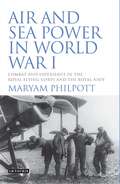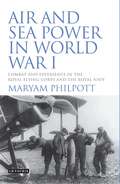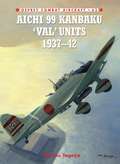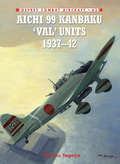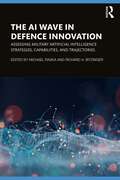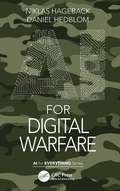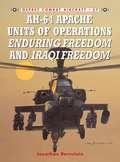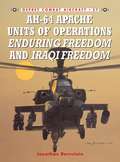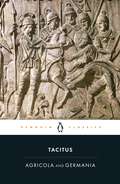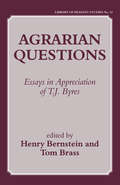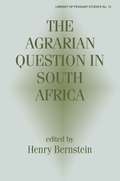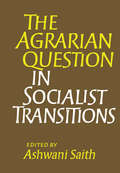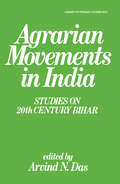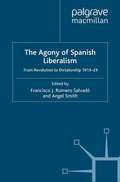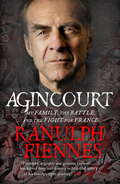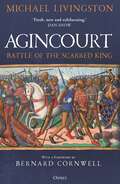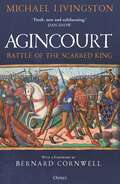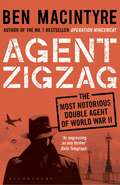- Table View
- List View
Air and Sea Power in World War I: Combat and Experience in the Royal Flying Corps and the Royal Navy
by Maryam PhilpottThe Great War tore the fabric of Europe apart, killing over 35 million men and challenging the notion of heroism in war, Air and Sea Power in World War I focuses on the experience of World War I from the perspective of British pilots and sailors themselves, to demonstrate that the army-centric view of war studies has been too limited. The Royal Flying Corps, created in 1912, adapted quickly to the needs of modern warfare, driven by the enthusiasm of its men. In contrast, the lack of modernisation in the Royal Navy, despite the unveiling of HMS Dreadnought in 1906, undermined Britain's dominance of the seas. By considering five key aspects of the war experience, this book analyses how motivation was created and sustained. What training did men receive and how effectively did this prepare them for roles that were predominantly non-combative? How was motivation affected by their individual relationship with weaponry development, and how different was defensive service on the Home Front, when in close proximity to ordinary civilian life?Finally, Air and Sea Power in World War I looks at the changing reputation of the services during and after the conflict, and the extent to which these notions were created by the memoirs of pilots and sailors. Featuring new primary source material, including the journals of service men themselves, this book will be essential reading for students and scholars of World War I and of Naval, Aviation and Military History.
Air and Sea Power in World War I: Combat and Experience in the Royal Flying Corps and the Royal Navy (International Library of War Studies)
by Maryam PhilpottThe Great War tore the fabric of Europe apart, killing over 35 million men and challenging the notion of heroism in war. Air and Sea Power in World War I focuses on the experience of World War I from the perspective of British pilots and sailors themselves, to demonstrate that the army-centric view of war studies has been too limited. The Royal Flying Corps, created in 1912, adapted quickly to the needs of modern warfare, driven by the enthusiasm of its men. In contrast, the lack of modernisation in the Royal Navy, despite the unveiling of HMS Dreadnought in 1906, undermined Britain's dominance of the seas. By considering five key aspects of the war experience, this book analyses how motivation was created and sustained. Featuring new primary source material, including the journals of servicemen themselves, this book will be essential reading for students and scholars of World War I and of Naval, Aviation and Military History.
Aichi 99 Kanbaku 'Val' Units: 1937-42 (Combat Aircraft)
by Jim Laurier Osamu TagayaThe Aichi Type 99 Carrier Bomber (D3A) – code named 'Val' by Allied intelligence – was the mainstay of the Imperial Japanese Navy's carrier dive-bomber force from 1941 to 1943. It sank more Allied warship tonnage than any other Axis aircraft during World War 2. While the Val's participation in the major carrier battles has been widely covered in other English language sources, details of its operations have received scant attention in English. This book explores the Val's combat operations. Colour illustrations and photographs complement the development of dive-bombing methods in the IJN.
Aichi 99 Kanbaku 'Val' Units: 1937-42 (Combat Aircraft #63)
by Jim Laurier Osamu TagayaThe Aichi Type 99 Carrier Bomber (D3A) – code named 'Val' by Allied intelligence – was the mainstay of the Imperial Japanese Navy's carrier dive-bomber force from 1941 to 1943. It sank more Allied warship tonnage than any other Axis aircraft during World War 2. While the Val's participation in the major carrier battles has been widely covered in other English language sources, details of its operations have received scant attention in English. This book explores the Val's combat operations. Colour illustrations and photographs complement the development of dive-bombing methods in the IJN.
The AI Wave in Defence Innovation: Assessing Military Artificial Intelligence Strategies, Capabilities, and Trajectories
by Michael RaskaAn international and interdisciplinary perspective on the adoption and governance of artificial intelligence (AI) and machine learning (ML) in defence and military innovation by major and middle powers. Advancements in AI and ML pose pressing questions related to evolving conceptions of military power, compliance with international humanitarian law, peace promotion, strategic stability, arms control, future operational environments, and technology races. To navigate the breadth of this AI and international security agenda, the contributors to this book include experts on AI, technology governance, and defence innovation to assess military AI strategic perspectives from major and middle AI powers alike. These include views of how the United States, China, Japan, South Korea, the European Union, and Russia see AI/ML as a technology with the potential to reshape military affairs and power structures in the broader international system. This diverse set of views aims to help elucidate key similarities and differences between AI powers in the evolving strategic context. A valuable read for scholars of security studies, public policy, and STS studies with an interest in the impacts of AI and ML technologies.
The AI Wave in Defence Innovation: Assessing Military Artificial Intelligence Strategies, Capabilities, and Trajectories
An international and interdisciplinary perspective on the adoption and governance of artificial intelligence (AI) and machine learning (ML) in defence and military innovation by major and middle powers. Advancements in AI and ML pose pressing questions related to evolving conceptions of military power, compliance with international humanitarian law, peace promotion, strategic stability, arms control, future operational environments, and technology races. To navigate the breadth of this AI and international security agenda, the contributors to this book include experts on AI, technology governance, and defence innovation to assess military AI strategic perspectives from major and middle AI powers alike. These include views of how the United States, China, Japan, South Korea, the European Union, and Russia see AI/ML as a technology with the potential to reshape military affairs and power structures in the broader international system. This diverse set of views aims to help elucidate key similarities and differences between AI powers in the evolving strategic context. A valuable read for scholars of security studies, public policy, and STS studies with an interest in the impacts of AI and ML technologies.
AI for Digital Warfare (AI for Everything)
by Niklas Hageback Daniel HedblomAI for Digital Warfare explores how the weaponising of artificial intelligence can and will change how warfare is being conducted, and what impact it will have on the corporate world. With artificial intelligence tools becoming increasingly advanced, and in many cases more humanlike, their potential in psychological warfare is being recognised, which means digital warfare can move beyond just shutting down IT systems into more all-encompassing hybrid war strategies.
AI for Digital Warfare (AI for Everything)
by Niklas Hageback Daniel HedblomAI for Digital Warfare explores how the weaponising of artificial intelligence can and will change how warfare is being conducted, and what impact it will have on the corporate world. With artificial intelligence tools becoming increasingly advanced, and in many cases more humanlike, their potential in psychological warfare is being recognised, which means digital warfare can move beyond just shutting down IT systems into more all-encompassing hybrid war strategies.
AH-64 Apache Units of Operations Enduring Freedom & Iraqi Freedom (Combat Aircraft)
by Jim Laurier Jonathan BernsteinAfter the attacks on 11 September 2001, Apache units made significant contributions to the Coalition campaign against Taliban and al-Qaeda forces in Afghanistan. Functioning as the 'killer' part of US Army Hunter-killer teams, Apaches sought out and brought overwhelming firepower to bear on Taliban and al-Qaeda forces, as well as providing direct support to Coalition troops on the ground. Apaches spearheaded the advance of the 3rd Infantry and the 101st airborne divisions into Iraq, engaging in some of the heaviest fighting along the western axis of advance. Weather and enemy fire took a heavy toll on Apaches operating in Western Iraq, but the resilience and flexibility of the Apache was central to the success of this campaign.
AH-64 Apache Units of Operations Enduring Freedom & Iraqi Freedom (Combat Aircraft #57)
by Jim Laurier Jonathan BernsteinAfter the attacks on 11 September 2001, Apache units made significant contributions to the Coalition campaign against Taliban and al-Qaeda forces in Afghanistan. Functioning as the 'killer' part of US Army Hunter-killer teams, Apaches sought out and brought overwhelming firepower to bear on Taliban and al-Qaeda forces, as well as providing direct support to Coalition troops on the ground. Apaches spearheaded the advance of the 3rd Infantry and the 101st airborne divisions into Iraq, engaging in some of the heaviest fighting along the western axis of advance. Weather and enemy fire took a heavy toll on Apaches operating in Western Iraq, but the resilience and flexibility of the Apache was central to the success of this campaign.
Agricola and Germania: Edited On The Basis Of Draeger's Agricola And Schweizer-didler's Germania (Penguin Classics Series)
by Tacitus H. MattinglyThe Agricola is both a portrait of Julius Agricola - the most famous governor of Roman Britain and Tacitus' well-loved and respected father-in-law - and the first detailed account of Britain that has come down to us. It offers fascinating descriptions of the geography, climate and peoples of the country, and a succinct account of the early stages of the Roman occupation, nearly fatally undermined by Boudicca's revolt in AD 61 but consolidated by campaigns that took Agricola as far as Anglesey and northern Scotland. The warlike German tribes are the focus of Tacitus' attention in the Germania, which, like the Agricola, often compares the behaviour of 'barbarian' peoples favourably with the decadence and corruption of Imperial Rome.
Agrarian Questions: Essays in Appreciation of T. J. Byres
by Henry Bernstein Tom BrassThis collection celebrates T.J. Byres' seminal contributions to the political economy of the agrarian question. Uniting the various themes is the demonstration of the continuing relevance of a critical, historical and comparative materialist analysis of agrarian question.
Agrarian Questions: Essays in Appreciation of T. J. Byres
by Henry Bernstein Tom BrassThis collection celebrates T.J. Byres' seminal contributions to the political economy of the agrarian question. Uniting the various themes is the demonstration of the continuing relevance of a critical, historical and comparative materialist analysis of agrarian question.
The Agrarian Question in South Africa
by Henry BernsteinThis is the first collection of its kind. It presents a critical political economy of the agrarian question in post-apartheid South Africa, informed by the results of research undertaken since the transition from apartheid started in 1990. The articles, by well-known South African, British and American scholars, cover a variety of topical theoretical, empirical and policy issues, firmly rooted in an historical perspective.
The Agrarian Question in South Africa
by Henry BernsteinThis is the first collection of its kind. It presents a critical political economy of the agrarian question in post-apartheid South Africa, informed by the results of research undertaken since the transition from apartheid started in 1990. The articles, by well-known South African, British and American scholars, cover a variety of topical theoretical, empirical and policy issues, firmly rooted in an historical perspective.
The Agrarian Question in Socialist Transitions
by Ashwani SaithFirst published in 1986. Routledge is an imprint of Taylor & Francis, an informa company.
The Agrarian Question in Socialist Transitions
by Ashwani SaithFirst published in 1986. Routledge is an imprint of Taylor & Francis, an informa company.
Agrarian Movements in India: Studies on 20th Century Bihar
by Arvind N. DasFirst published in 1982. Routledge is an imprint of Taylor & Francis, an informa company.
Agrarian Movements in India: Studies on 20th Century Bihar
by Arvind N. DasFirst published in 1982. Routledge is an imprint of Taylor & Francis, an informa company.
The Agony of Spanish Liberalism: From Revolution to Dictatorship 1913–23
by Francisco J. Romero SalvadóIt was during the period 1913-1923 that the seeds of political polarization and social violence culminating in the Spanish Civil War were sown. This volume explores the causes of the growing schism within Spanish society, focusing on the crisis of the Spanish liberal order, under challenge from newly mobilized forces on both the Right and Left.
Agonistic Memory and the Legacy of 20th Century Wars in Europe (Palgrave Macmillan Memory Studies)
by Stefan Berger Wulf KansteinerThis book discusses the merits of the theory of agonistic memory in relation to the memory of war. After explaining the theory in detail it provides two case studies, one on war museums in contemporary Europe and one on mass graves exhumations, which both focus on analyzing to what extent these memory sites produce different regimes of memory. Furthermore, the book provides insights into the making of an agonistic exhibition at the Ruhr Museum in Essen, Germany. It also analyses audience reaction to a theatre play scripted and performed by the Spanish theatre company Micomicion that was supposed to put agonism on stage. There is also an analysis of a Massive Open Online Course (MOOC) designed and delivered on the theory of agonistic memory and its impact on the memory of war. Finally, the book provides a personal review of the history, problems and accomplishments of the theory of agonistic memory by the two editors of the volume.
Agincourt: My Family, the Battle and the Fight for France
by Ranulph Fiennes25 October 2015 was the 600th anniversary of the battle of Agincourt - a hugely resonant event in English (and French) history. Sir Ranulph Fiennes casts new light on this epic event, revealing that three of his own ancestors fought in the battle for Henry V, and at least one for the French. This is a unique perspective on Agincourt from a trained and decorated soldier. Ran reveals the truth behind the myths and legends of the battle. He tells how after the battle Henry V entertained his senior commanders to dinner, where they were waited on by captured French knights. There is the story of Sir Piers Legge of Lyme Hall, who lay wounded in the mud while his mastiff dog fought off the French men-at-arms. Then there is the legend that the French intended to cut off the first and second right hand fingers of every captured archer, to prevent him from using his bow. The archers raised those two fingers to the advancing French as a gesture of defiance. In this gripping study Sir Ranulph Fiennes brings back to life these stories and more, including those of his own ancestors, in a celebration of a historical event integral to English identity.Fiennes, arguably our greatest explorer...has delved deep into history to tell the story of his family's epic journey. - The Times
Agincourt: Battle of the Scarred King
by Dr Michael LivingstonAgincourt is one of the most famous battles in English history, a defining part of the national myth. This groundbreaking study by Mike Livingston, author of Never Greater Slaughter, presents a new interpretation of Henry V's great victory.'It's quite a feat to write an account of England's most famous battle that makes the reader feel like they're experiencing history that is fresh, new and exhilarating.' Dan Snow King Henry V's victory over the French armies at Agincourt on 25 October 1415 is unquestionably one of the most famous battles in history. From Shakespeare's 'band of brothers' speech to its appearances in numerous films, Agincourt rightfully has a place among a handful of conflicts whose names are immediately recognized around the world. The English invasion of France in 1415 saw them take the French port of Harfleur after a long siege, following which Henry was left with a sick and weakened army, which he chose to march across Normandy to the port of Calais against the wishes of his senior commanders. The French had assembled a superior force and shadowed the English Army before finally blocking its route. The battle that followed was an overwhelming victory for the English, with the French suffering horrific casualties. Agincourt opened the door for Henry V's further conquests in France. Agincourt provides a new look at this famous battle. Mike Livingston goes back to the original sources, including the French battle plan that still survives today, to give a new interpretation, one that challenges the traditional site of the battlefield itself. It is a thrilling new history that not only rewrites the battle as we know it, but also provides fresh insights into the men who fought and died there.
Agincourt: Battle of the Scarred King
by Dr Michael LivingstonAgincourt is one of the most famous battles in English history, a defining part of the national myth. This groundbreaking study by Mike Livingston, author of Never Greater Slaughter, presents a new interpretation of Henry V's great victory.'It's quite a feat to write an account of England's most famous battle that makes the reader feel like they're experiencing history that is fresh, new and exhilarating.' Dan Snow King Henry V's victory over the French armies at Agincourt on 25 October 1415 is unquestionably one of the most famous battles in history. From Shakespeare's 'band of brothers' speech to its appearances in numerous films, Agincourt rightfully has a place among a handful of conflicts whose names are immediately recognized around the world. The English invasion of France in 1415 saw them take the French port of Harfleur after a long siege, following which Henry was left with a sick and weakened army, which he chose to march across Normandy to the port of Calais against the wishes of his senior commanders. The French had assembled a superior force and shadowed the English Army before finally blocking its route. The battle that followed was an overwhelming victory for the English, with the French suffering horrific casualties. Agincourt opened the door for Henry V's further conquests in France. Agincourt provides a new look at this famous battle. Mike Livingston goes back to the original sources, including the French battle plan that still survives today, to give a new interpretation, one that challenges the traditional site of the battlefield itself. It is a thrilling new history that not only rewrites the battle as we know it, but also provides fresh insights into the men who fought and died there.
Agent Zigzag: The True Wartime Story of Eddie Chapman: Lover, Traitor, Hero, Spy (reissued)
by Ben MacintyreOne December night in 1942, a Nazi parachutist landed in a Cambridgeshire field. His mission: to sabotage the British war effort. His name was Eddie Chapman, but he would shortly become MI5's Agent Zigzag. Dashing and louche, courageous and unpredictable, the traitor was a patriot inside, and the villain a hero. The problem for Chapman, his many lovers and his spymasters was knowing who he was. Ben Macintyre weaves together diaries, letters, photographs, memories and top-secret MI5 files to create the exhilarating account of Britain's most sensational double agent.
